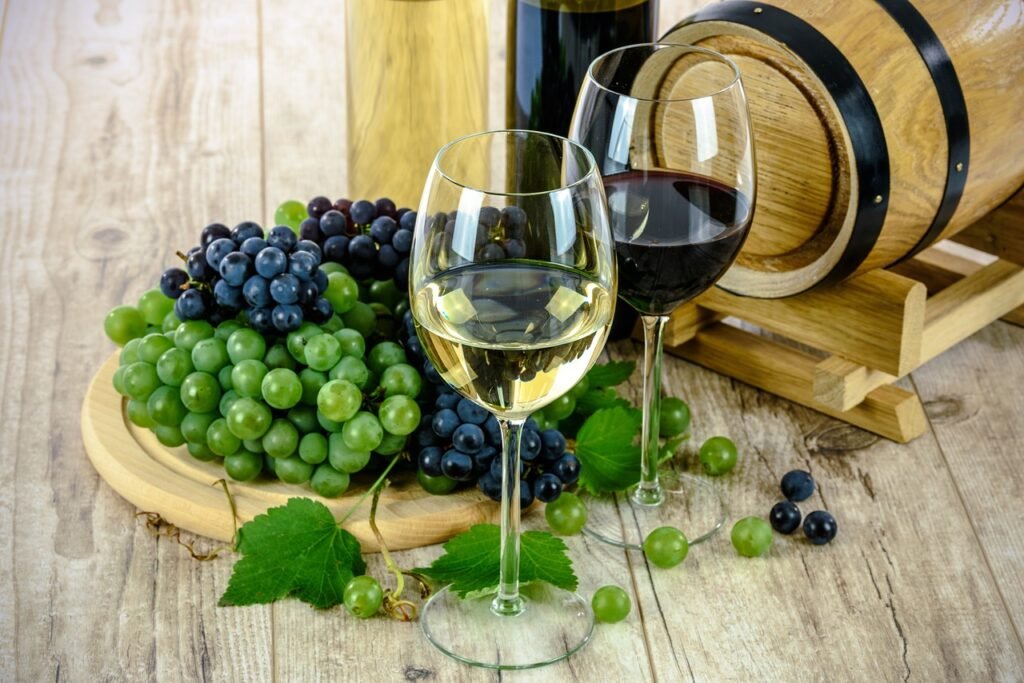
Where does wine get its colour?
White wine is made from white grapes, red wine from red grapes and rose wine is a mix of the two, right? Well, would it surprise you to know that is actually not correct?!
As we have discovered previously, wine comes predominantly from the juice of the grape, which is then fermented which turns sugars into alcohol. But red (often referred to as black or blue) and white (often referred to as green grapes) have juice which is almost entirely colourless. So it is entirely possible to make a white wine from a red grape, although for reasons we are about to discover you can never make a rose or red wine from a white grape.
So if the colour of a wine isn’t because red and white grapes produce different coloured juice, where does the colour come from? Well to understand that, we have to understand a little bit about two different ways to make wine.
Method one: The grapes are crushed, pressed and the juice separated from the skins, taken away and fermented. I’m simplifying a lot, but you get the idea.
Method two: The grapes are crushed, but not immediately pressed. Instead, they remain in contact with the skins and other parts of the grape.
In the second method, the juice is in contact with the part of the grape which does have colour – the skin. The anthocyanin contained in the skins gets released into the wine and, a little bit like adding ink to water, makes the liquid change colour. Hence why, as we said above, you cannot make a rose or red wine from white grapes, because the skins do not contain red pigments.
So to make a white wine from a red grape, we use method one, taking the juice out of contact with the skins before the pigment is released into them. And to make a red wine, we leave the juice in contact with the red pigmented skins. Generally the longer we leave the wine in contact with the skins, the more pigment will be released and the darker the wine will be. Generally when making a red wine, it is common to also try to get some movement into the wine to mix the skins with more of the liquid. There are various methods for doing this which we will cover in a later post.
So if we know that, the longer you leave grape juice in contact with the skins, the darker the colour, it isn’t hard to see how we might make Rose wine. We simply leave the grape juice in contact with the skins of the red grapes for a short period of time so that they take on a small amount of the pigment.
But what happens if we leave white grapes in contact with their skins? I’m glad you asked! When we leave a white grape in contact with its skin a similar process occurs to when we do this with with red grapes, some of the skin pigment is released into the grape juice resulting in a colour change. In this scenario, the colour change is not to red or pink, but usually to something closer to orange in colour. And this is what is known as orange wine! If you haven’t tried an orange wine, I’d highly recommend it.
It is actually a relatively recent concept that wine would be drained off its skins to create a ‘clean’ wine. When we think about how wines were traditionally made in places like Georgia (which many believe is one of the birthplaces of wine), they would all have likely been made with skin contact.
So, having told you that Rose wine is made from red grapes, I’m also going to tell you that if you thought it was made from mixing red and white wine, you weren’t completely wrong. There is one very famous place where Rose wine is legally allowed to be made by mixing red and white wine – Champagne!
Of course there are all kinds of other reasons why a wine may have a certain shade of colour: Aging in barrels can add colour, certain wine making techniques can impact on the amount of colour which is extracted, sometimes wine makers even blend wines together which can impact their colour, and of course the grape variety and how ripe it is can also impact the colour significantly. One way professional tasters define the shades is:
White: Lemon – Gold – Amber – Brown
Rose: Pink – Pink-Orange – Orange (Not the same as Orange wine)
Red: Purple – Ruby – Garnet – Tawny
Hopefully next time you open a bottle you will be able to identify what shade of colour it is and now know where the colour came from! In the meantime, keep exploring this beautiful planet we live on, one glass at a time!